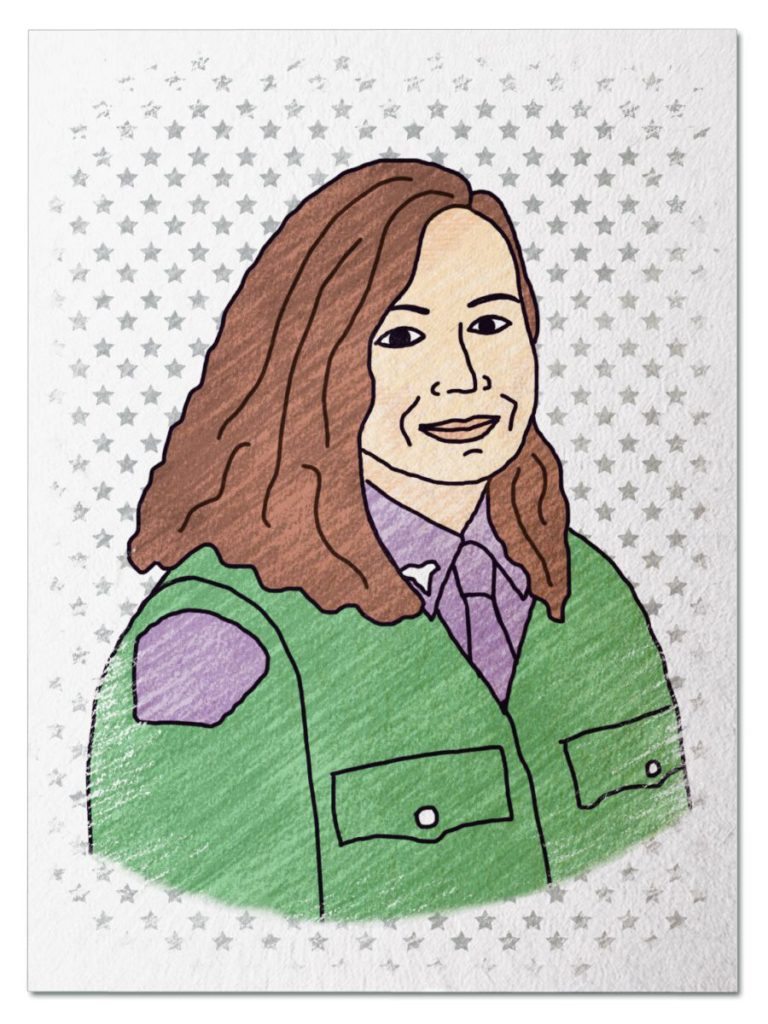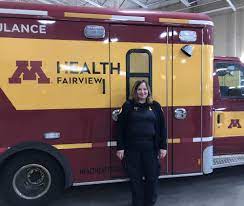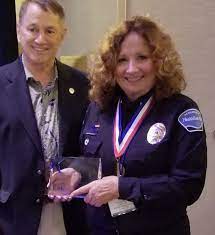
Health Hero
She was a 21 year old hospital housekeeper who said yes to a dare to enroll in a paramedic program in an era when women simply were not hired as first responders. After graduation, she convinced a local hospital to hire her, became one of the first woman paramedics in the United States, and built a nearly 50 year career. Travel back in time to 1973 and meet Rose Pelzel…
Her Ruby Shoe Moment
The Power of the Wand
Her Yellow Brick Road
Brains, Heart & Courage
Glinda’s Gallery
Just the Facts
Her Ruby Shoe Moment
Paramedic Rose Pelzel jumped out of the ambulance that had taken her to the Minneapolis suburb of Eagan. She and her partner were responding to a 911 call from a panicked parent whose young son had been pulled out of the bottom of a swimming pool. Two bystanders and a fire crew had also responded. The boy was unresponsive. Rose stepped into action as she always did, calmly and with the confidence that she knew what needed to be done. They began CPR on the boy, alternating chest compressions with breaths, knowing that with drowning victims, sometimes water in the lungs hinders their ability to expand. They kept at it, working feverishly and using every tool in their arsenal to bring him back to consciousness.

Rose in front of her primary workplace – her ambulance (M Health Fairview)
Their actions saved the boy’s life. Rose, thinking of her own children, was overwhelmed with gratitude that she was able to make a difference. And when she had time to talk with the boy’s father, “the look on his face of appreciation and that he was so close to losing his son, that was the moment for me that I knew it couldn’t get better.” And Rose reflected that the deep connection she felt with him in that moment would never have happened if she hadn’t accepted a dare from a friend more than 40 years earlier. The dare? – enrolling in an Emergency Medical Services/Paramedic program.
When Rose graduated from her paramedic program in 1973, she was a woman applying for a job in a man’s world. There were no women paramedics. She talked the management at Devine Redeemer, a small community hospital, into taking a chance on her. She wasn’t deterred by their reluctance. Instead she pressed her case, even though she could tell it “was obvious they were very hesitant to have a woman out there.” As Rose worked her first shifts as a frontline paramedic, she quickly realized that one of the most important skills to develop was to stay calm no matter what she encountered. Emergencies are intense, high-stress situations. Rose learned to be ready to respond to the unexpected.
 Emergency room doctors tend to get the attention and credit for saving lives, but often it is the paramedic at the scene who is the reason the patient survived long enough to get there. And Rose was typically overlooked more than most paramedics because she was a woman. For example, when she brought patients into the ER, doctors and nurses assumed she was a family member and would ask her to wait in the lobby or family area. For years, Rose had to specifically tell the ER staff that she was there with the patient and part of the treatment team – even though she was wearing her uniform! They simply didn’t expect a woman paramedic to walk through their doors.
Emergency room doctors tend to get the attention and credit for saving lives, but often it is the paramedic at the scene who is the reason the patient survived long enough to get there. And Rose was typically overlooked more than most paramedics because she was a woman. For example, when she brought patients into the ER, doctors and nurses assumed she was a family member and would ask her to wait in the lobby or family area. For years, Rose had to specifically tell the ER staff that she was there with the patient and part of the treatment team – even though she was wearing her uniform! They simply didn’t expect a woman paramedic to walk through their doors.
Rose had come a long way since those first days as the only woman paramedic in town. Early in her career, she became part of the first Mobile Intensive Care Unit (MICU) team in the Upper Midwest. And when Divine Redeemer merged into HealthEast Ambulance, which then became a part of the University of Minnesota Fairview Health System, Rose went from being a paramedic in a small community to working in a large network that handled a significant percentage of emergency calls in the Twin Cities.
All those years of perseverance and commitment had led her to this moment – going home to her family after saving the life of the young boy who nearly drowned. She felt the same connection to him and his family that she did to all of the people she had encountered over the years, because on every call she made sure to live by her own personal paramedic philosophy: “Be with your patient. Treating your patient is not being with them. Find a way to connect and be with them”
The Power of the Wand
 Rose retired from her career as a paramedic in 2021, after 50 years on the job. When she retired, she was the longest serving paramedic in the United States. Rose was also one of the first women to ever do the job. She blazed a trail that other women followed, and as more women joined her crew at University of Minnesota Health Fairview, she mentored them. The culture she set attracted more and more women, and Rose watched as women in the ranks grew.
Rose retired from her career as a paramedic in 2021, after 50 years on the job. When she retired, she was the longest serving paramedic in the United States. Rose was also one of the first women to ever do the job. She blazed a trail that other women followed, and as more women joined her crew at University of Minnesota Health Fairview, she mentored them. The culture she set attracted more and more women, and Rose watched as women in the ranks grew.
Even today, only 34% of EMTs and 21% of paramedics are women. And it is still big news when a team of paramedics is all female – like this team of strong women in Brownwood, Texas, who were their town’s first all female EMS shift ever… in 2021.
Her Yellow Brick Road
As a young woman, Rose supported herself by working as a housekeeper at a Minnesota hospital. She was inspired by her medical surroundings to enroll in an Advanced First Aid class in South St. Paul. Rose was the only woman in her class, but she didn’t dwell on it. Instead, she focused on the material, which she found fascinating. She talked about what she learned so much that a friend dared 21 year old Rose to try paramedic/first responder training. She accepted the challenge.

Rose and partner in the early days (M Health Fairview)
It wasn’t easy. It was 1972, and emergency medicine was dominated by men, especially out in the field. Being a paramedic simply wasn’t considered a woman’s job – even though the idea to treat patients at the scene of an emergency, rather than wait until they arrived at the hospital, originated with a woman during the Civil War. It was Red Cross Nurse Clara Barton who encouraged battlefield nurses to “treat them (the soliders) where they lie.”
Emergency medicine had its modern start just a few years earlier. In 1966, a study titled “Accidental Death and Disability: The Neglected Disease of Modern Society” changed the playing field. The study’s authors analyzed car accident fatalities, and determined that emergency care at the scene would save thousands of lives every year. Too many accident victims died on the way to the hospital because they needed immediate resuscitation and first aid. Every minute counted. Communities around the country began looking around for people to train in pre-hospital emergency medicine.
 Initially, paramedics were based out of fire departments, so to be a paramedic you had to be a firefighter. And fire departments were notorious for their unwillingness to hire women. Even female candidates who successfully completed fire academy training were flunked out on technicalities. When hospitals began to train their own paramedics, the barriers became a little easier to climb. A Pittsburgh ER doctor named Dr. Nancy Caroline developed the first comprehensive EMS textbook, called “Emergency Care in the Streets.” This became a foundation for all the new programs being developed around the country, including in Minnesota, where Rose was enrolled.
Initially, paramedics were based out of fire departments, so to be a paramedic you had to be a firefighter. And fire departments were notorious for their unwillingness to hire women. Even female candidates who successfully completed fire academy training were flunked out on technicalities. When hospitals began to train their own paramedics, the barriers became a little easier to climb. A Pittsburgh ER doctor named Dr. Nancy Caroline developed the first comprehensive EMS textbook, called “Emergency Care in the Streets.” This became a foundation for all the new programs being developed around the country, including in Minnesota, where Rose was enrolled.
In her program, Rose learned paramedics and EMTs are both part of the EMS team. They bridge the gap between the scene of an emergency and the hospital, and their job is to do everything they can to keep the patient alive until they arrive at the hospital. EMTs stabilize patients at the scene with oxygen masks and defibrillators, but must defer to paramedics if more invasive treatment is necessary. Paramedics are trained and certified to administer IV medication, draw blood for medical tests, and administer antidotes for overdoses or poisonings. They also clear airways, perform tracheotomies, and intubate patients with mechanical breathing devices. Rose also learned that as a paramedic, she would be responsible for giving the emergency medicine staff a detailed account of her patient’s condition once they arrive at the hospital. Often paramedics stay in the ER to assist with the patients continued care.

Rose receiving STARS of Life Award in 2019 (M Health Fairview)
Since first responders work as a team, Rose made sure she was up to the physical standards of the job. She never wanted to be in a position where she needed to ask one of her male colleagues to do any heavy lifting for her. While her presence in the program, and on the job, was viewed with suspicion in the male dominated field when she started, her skill and work effort won over her colleagues. Rose lived by her belief that “you cannot do this alone, and I think it’s important to remember that so that you treat your partners with respect.”
Brains, Heart & Courage
Rose grew up with 5 brothers. They treated her as one of them. She was part of their roughhousing, learned how to wrestle, and always had to carry her own stuff.
Driven to help people, she was inspired by the Parable of the Good Samaritan Luke 10:25-37: “Love your neighbor as yourself.” Her mission in life was to find the good in everyone.
Glinda’s Gallery
Just the Facts
- In the late 1980s, Rose served as a member of one of the first ever Critical Incident Stress Debriefing (CISD) teams in the Upper Midwest. The CISD teams helped paramedics work through their emotions after responding to particularly difficult, stressful, and/or tragic emergencies. Post-traumatic stress disorder (PTSD) can have lasting damage on first responders and “burn-out” from the job ended many paramedic careers early. Rose was able to share what she had learned dealing with her own struggles with burn-out, which led her to consider quitting at least three times during her career.
- Rose filled many roles during her career, including as a Critical Care Paramedic, Crew Supervisor, and Preceptor. But her favorite role was as a a field training officer. She took pride in helping her “baby medics” develop into capable and compassionate paramedics and technicians.
- Rose retired with many honors and kudos. The Chief of Emergency Medical Services at M Health Fairview observed that Rose’s “drive and dedication to the field of paramedicine has been extraordinary to say the least.”
- Rose treated tens of thousands of patients during her career.
- Rose trained and is certified in reiki, a Japanese form of energy healing. After retirement, she continues to use that skill to help people. She also is enjoying having more time to spend on her roles as a mom, grandma, and friend.
- Rose was honored with a 2019 Stars of Life Award by the American Ambulance Association.
Want to Know More?
EMSFSN Staff. “Street Medic Honored for Nearly 50 Years of Service” (Flightsafetynet.com).
Mohs, Marielle. “Rose Pelzel, First Woman To Become a Paramedic, Retires After 50 Years” (CBS Minnesota April 1, 2021).
Staats, Kathy. “Crashing the Party: Women of EMS” (Females Working in Emergency Medicine Feb. 20, 2018).
Staff. “After A Nearly 50-Year Career, One of the Twin Cities’ First Female Paramedics Retires.” (M Health Fairview April 1, 2021).
Staff. “Rose Pelzel” (Stars of Life 2019).
WebMD Editorial Contributors. “What Is A Paramedic” (Web MD).
